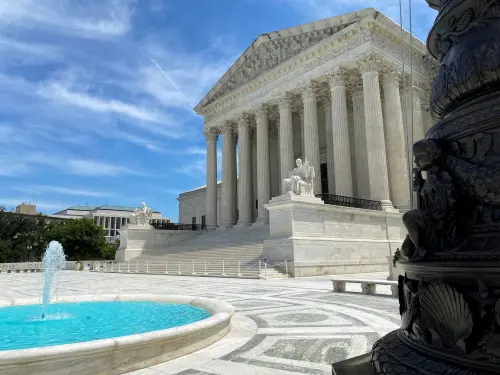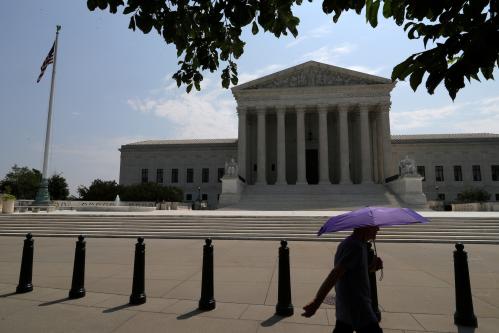Donald Trump’s term in office represents an extraordinary development that goes beyond his egregious effort to overturn the results of a presidential election. It also extends to what political scientists have called the administrative or unilateral presidency: how presidents seek to transform domestic policy through executive initiatives without congressional approval. In one policy sphere after another the Trump administration initiated executive actions to transform, often quite radically, who gets what, when, and how from the federal government. Kenneth Wong, Barry Rabe and I have documented this development with respect to education, climate, and health care policies in our recent book from Brookings Press, Trump, the Administrative Presidency, and Federalism. In pursuing an administrative presidency on steroids, however, Trump regularly ran into opposition from the federal courts. District courts frequently responded to suits from Democratic state attorneys general and private parties by blocking implementation of his initiatives through national injunctions or other means.
President Biden, while pursuing a sharply different policy agenda, is also poised to vigorously employ executive initiatives to achieve his objectives. In his first day of office alone, he issued 17 executive orders, memoranda, and proclamations. This pattern naturally raises questions concerning the degree to which Republican state attorneys general and conservative interest groups will turn to lower federal courts to stymie the Biden administration. (On day six of the new administration, one such action came to fruition when a district court judge in Texas enjoined a Biden action on immigration policy.) Somewhat ironically, however, the Supreme Court may move to undercut the veto power of district courts (more on this below).
The national injunction is one important tool in checking presidential power that the 94 federal district courts located throughout the country possess. Beginning in the 1960s, district court judges have become increasingly willing to issue sweeping injunctions that block executive actions nationwide rather than in the more narrowly defined geographic jurisdictions in which they operate. District courts employed this tool to deal the Trump administration an array of setbacks. For example, a district court halted Trump’s first executive order which sought to prevent the residents of seven countries from entering the United States. Important executive initiatives of his presidential predecessors at times met a similar fate. In 2015, for instance, a district court blocked implementation of an Obama administration directive which would have granted deferred action status to certain undocumented parents, protecting them from deportation and allowing them to obtain work permits.
More recently, however, an opinion by Associate Justice Neil Gorsuch has suggested a potential Supreme Court willingness to curtail the ability of lower courts to issue nationwide injunctions. The case that triggered Gorsuch’s opinion involved the Trump administration’s efforts to discourage “legal aliens” and their families from becoming “public charges” by signing up for Medicaid. A public charge rule issued by the Department of Homeland Security in August 2019 focused on legally present noncitizens seeking to extend their stays in the United States or to change their immigration status (for example, from temporary to permanent resident). Federal administrative action since 1999 permitted immigration officials to consider as a negative factor whether an applicant had received government cash benefits, such as welfare payments, when they made these decisions. The new rule sought to extend this adverse standard to noncash benefits, such as Medicaid enrollment. Opponents argued with considerable supporting evidence that the rule would depress the willingness of this cohort to obtain the insurance needed to assure access to health care for themselves and their children.
Promulgation of the rule kindled a flurry of lawsuits in federal district courts across the country. At least three different groups of Democratic state attorneys general filed suits opposing the regulation. Private parties, such as the California Primary Care Association, filed others. Several district courts sided with the plaintiffs seeking to invalidate the rule. In doing so, certain of these courts overturned it in specific geographic areas within their jurisdictions (e.g., the state of Illinois). But district courts in the states of Washington and Maryland issued national injunctions forbidding the Department of Homeland Security from implementing the law anywhere. In these two cases, two different courts of appeals halted the injunction at least until the Supreme Court decided whether to hear the case. But a third national injunction from a federal district judge in New York was not blocked by an appellate court. Hence, the Trump administration appealed to the Supreme Court to stay the injunction.
In January 2020, the Supreme Court in a five-to-four decision (with the then-four justices appointed by Democratic presidents dissenting) granted the stay (Department of Homeland Security et al. v. New York et al.). This enabled the Department of Homeland Security to resume its implementation of the rule. Justice Neil Gorsuch joined by Justice Clarence Thomas used the occasion to assert that the “real problem here is the increasingly common practice of trial courts ordering relief that transcends the cases before them.” He averred that the propensity of district courts to issue national injunctions made public administration “unworkable, sowing chaos for litigants, the government, courts, and all those affected…” He further affirmed that “by their nature, universal injunctions tend to force judges into making rushed, high-stakes, low-information decisions.” In closing, he expressed hope that the Supreme Court would take up some of “the equitable and constitutional questions raised by the rise of national injunctions.”
Whether in fact the Supreme Court will curb the use of national injunctions by district courts remains to be seen. But it is worth noting the implications of any such a step for the Biden administrative presidency as well as those of his successors. National injunctions by lower courts empower, at least over the short to intermediate term, the ability of states and private parties to stymie the executive initiatives of a president. They are an efficient way for opponents of a president’s policy to prevail. Rather than expend resources filing suits in multiple courts whose rulings apply in limited geographic areas, opponents can hit the jackpot with one suit in one district court willing to unleash a national injunction. Moreover, forum shopping typically permits opponents to bring their suits to district court judges with a reputation for being receptive to their points of view. This shopping may extend to a consideration of which courts of appeals are more likely to uphold national injunctions. The injunction blocking implementation of the public charge rule nationwide rested not only on a New York district court decision but on concurrence by an appellate court in that circuit. In the public charge case opponents filed suits in multiple district courts to increase the odds that at least one judge would issue a nationwide injunction. In essence, the national injunction increases the number of veto points for presidential initiatives in the American system of fragmented governance. It applies the brakes to executive-initiated change at least until higher courts rule.
Given this dynamic, the Biden administrative presidency would likely benefit if the Supreme Court followed Gorsuch’s lead to restrain the use of national injunctions by lower courts. Biden will almost certainly launch a spate of executive initiatives in health care, climate, education, and other policy spheres. These initiatives would stand a better chance of getting off the ground in the face of near-certain suits from Republican state attorneys general and conservative interest groups if the ability of lower courts to issue nationwide injunctions has ebbed. This good news for the Biden administration would, however, need to be balanced by a longer-term consideration. When the Republicans at some point regain the presidency, especially if the new president has the authoritarian, demagogic propensities of Donald Trump, curtailing the ability of lower courts to issue national injunctions would weaken an important check on presidential power.
The Brookings Institution is committed to quality, independence, and impact.
We are supported by a diverse array of funders. In line with our values and policies, each Brookings publication represents the sole views of its author(s).











Commentary
Will the Supreme Court weaken lower-court checks on Biden’s executive power?
February 1, 2021